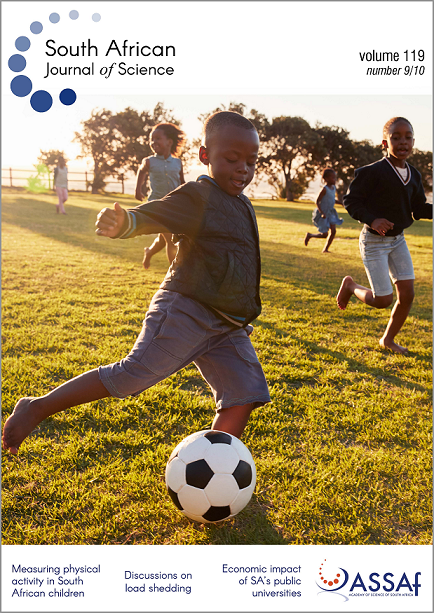Effect of manganese-rich solid waste on soil phosphorus availability applied as monopotassium and rock phosphate in two contrasting soils
DOI:
https://doi.org/10.17159/sajs.2023/15689Keywords:
phosphate rock, KH2PO4, incubation experiment, mining waste, South AfricaAbstract
Manganese (Mn) mining produces a large amount of Mn-rich solid waste contributing to soil and groundwater pollution. Adding Mn-rich waste to soils could reduce mining pollution by allowing specialised plants to take up this mineral for growth, that is, phytoremediation. However, Mn interacts with other soil major and trace minerals. The interaction with phosphorus (P), a key element for plant nutrition and growth, has received less attention. In this study, we aimed to evaluate the effects of P sources (i.e. rock phosphate and monopotassium [KH2PO4]) and application rates on the P and Mn relationships in clay and sandy soils mixed with Mn-rich waste. Soils differing in texture were incubated for 60 days at room temperature (±20 °C), and changes in available P, Mn and soil pH were determined at 0, 30 and 60 days. The addition of Mn-rich solid waste significantly decreased available soil P in both soils with the greatest reduction of 62% and 52% from the sandy soil subjected to KH2PO4 and rock phosphate, respectively. In the clayey soil, the reduction was higher for the rock phosphate source implying more P was released from the rock phosphate in Mn-rich soils. This explanation was supported by the significant positive correlation between P and Mn for both soils when P is added in the form of rock phosphate. Our results suggest that Mn-rich waste is better in clay soils subjected to rock phosphate addition. Further research is needed to control Mn solid waste pollution levels in soils using specific crops with known phytoremediation properties.
Significance:
South African mining and smelting processes produce a lot of Mn-rich waste as a by-product that harms the environment if not appropriately managed. The efficient use of Mn-rich solid waste in agricultural soils is poorly studied; hence, this study focused on the role of soil type and Mn-rich waste addition on phosphorus release and availability.
Published
Issue
Section
License

All articles are published under a Creative Commons Attribution 4.0 International Licence
Copyright is retained by the authors. Readers are welcome to reproduce, share and adapt the content without permission provided the source is attributed.
Disclaimer: The publisher and editors accept no responsibility for statements made by the authors
How to Cite
- Abstract 524
- PDF 709
- EPUB 131
- XML 343












.png)